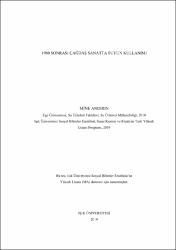| dc.contributor.advisor | Kara Sarıoğlu, Didem | en_US |
| dc.contributor.author | Andırın, Mine | en_US |
| dc.contributor.other | Işık Üniversitesi, Sosyal Bilimler Enstitüsü, Sanat Kuramı ve Eleştiri Yüksek Lisans Programı | en_US |
| dc.date.accessioned | 2019-10-24T01:58:37Z | |
| dc.date.available | 2019-10-24T01:58:37Z | |
| dc.date.issued | 2019-08-22 | |
| dc.identifier.citation | Andırın, M. (2019). 1960 sonrası çağdaş sanatta suyun kullanımı. İstanbul: Işık Üniversitesi Sosyal Bilimler Enstitüsü. | en_US |
| dc.identifier.uri | https://hdl.handle.net/11729/2216 | |
| dc.description | Text in Turkish ; Abstract: Turkish and English | en_US |
| dc.description | Includes bibliographical references (leaves 79-81) | en_US |
| dc.description | xiv, 81 leaves | en_US |
| dc.description.abstract | Tarih boyunca insanoğlu, canlılığının devamı için, varlığına muhtaçlığı sebebiyle suya yakın olmuştur. İlk yerleşim yerlerini su kenarlarına kurmuş, hastalıklarına şifayı suda aramış, kimi zaman da suyun gücünden korkarak suyu kutsallaştırmıştır. İnsanlık tarihinde büyük öneme sahip olan su, sanatçıları da etkilemiştir. Su kavramı, manzara resimleri ve mitolojik betimlemelerle, sanat tarihinde sıklıkla karşımıza çıkmaktadır. Bu tez çalışması, suyu salt bir malzeme veya tamamlayıcı unsur olarak görmeyip, kavramsal olarak ele alan çağdaş sanatçıların 1960 sonrası eserlerinde onu nasıl bir ifade aracına dönüştürdüklerini incelemektedir. Konu ele alınırken tarih boyunca insanoğlunun suya olan yaklaşımı araştırılmıştır. Suyun fiziksel ve kimyasal özellikleri, felsefe, mitoloji ve dinler tarihindeki yeri ve yaşamsal süreçteki önemi araştırılmış, devamında suyun çağdaş sanatçıların 1960 sonrası eserlerinde sanatçılar tarafından nasıl işlendiği analiz edilmiştir. Çalışma boyunca görülmüştür ki, 1960 sonrası sanat üretiminde suyun farklı halleri olmasından yararlanarak değişim ve dönüşümü ortaya koyan süreçlerin sergilendiği, gaz halinde mekana yayılmasının izleyeni deneyimleyene dönüştürdüğü saptanmış ve sanatçıların çalışmalarında suyu kullanma sebeplerinin farklı halleri olmasından, hayati öneminden kaynaklandığı tespit edilmiştir. | en_US |
| dc.description.abstract | Throughout history, human beings have been close to water due to their need for existence and survival of their vitality. They established the first settlements by the water and searched for healing for diseases. They were sometimes afraid of the power of water and sacrified it. Water, which has a great importance in the history of humanity, also affected artists. The concept of water is often encountered in art history with the landscape paintings and mythological descriptions. This thesis examines how contemporary artists, who do not see water as a mere material or complementary element, conceptually transform it into a means of expression in their post-1960 works. While approaching the subject, human approach to water has been researched throughout history. The physical and chemical properties of water, its place in the history of philosophy, mythology and religions and the place in life process were researched, and then how water was considered and treated by contemporary artists in their works after 1960 was analyzed. During the study, it was observed that, taking the advantage of the different states of water, processes that demonstrate change and transformation were exhibited in art production after 1960. It was found out that its spreading in a place made people experiencer rather than pursuer and it was also found out that the reasons artists use water in their works are different as it results from its vital importance. | en_US |
| dc.description.tableofcontents | GİRİŞ | en_US |
| dc.description.tableofcontents | SUYUN KİMYASAL YAPISI, HALLERİ VE YAŞAMSAL SÜREÇTE ÖNEMİ | en_US |
| dc.description.tableofcontents | Suyun Kimyasal Yapısı | en_US |
| dc.description.tableofcontents | Suyun Halleri | en_US |
| dc.description.tableofcontents | Suyun Yaşamsal Süreçte Önemi | en_US |
| dc.description.tableofcontents | DÜŞÜNCE TARİHİ ve SU | en_US |
| dc.description.tableofcontents | Felsefe ve Su | en_US |
| dc.description.tableofcontents | Dinler Tarihi ve Su | en_US |
| dc.description.tableofcontents | Mitolojide Su | en_US |
| dc.description.tableofcontents | Tek Tanrılı Dinlerde Su | en_US |
| dc.description.tableofcontents | ÇAĞDAŞ SANAT KAVRAMI ve ÇAĞDAŞ SANATTA SUYUN KULLANIMI | en_US |
| dc.description.tableofcontents | Çağdaş Sanat Kavramı | en_US |
| dc.description.tableofcontents | Çağdaş Sanatta Suyun Farklı Hallerde Kullanımı | en_US |
| dc.description.tableofcontents | Katı Hali | en_US |
| dc.description.tableofcontents | Sıvı Hali | en_US |
| dc.description.tableofcontents | Gaz Hali | en_US |
| dc.description.tableofcontents | SONUÇ | en_US |
| dc.language.iso | tr | en_US |
| dc.publisher | Işık Üniversitesi | en_US |
| dc.rights | info:eu-repo/semantics/openAccess | en_US |
| dc.rights | Attribution-NonCommercial-NoDerivs 3.0 United States | * |
| dc.rights.uri | http://creativecommons.org/licenses/by-nc-nd/3.0/us/ | * |
| dc.subject | Çağdaş sanat | en_US |
| dc.subject | Çevre | en_US |
| dc.subject | Dönüşüm | en_US |
| dc.subject | Su | en_US |
| dc.subject | Süreç | en_US |
| dc.subject | Contemporary art | en_US |
| dc.subject | Environment | en_US |
| dc.subject | Process | en_US |
| dc.subject | Transformation | en_US |
| dc.subject | Water | en_US |
| dc.subject.lcc | ND1460.W39 A53 2019 | |
| dc.subject.lcsh | Water in art. | en_US |
| dc.title | 1960 sonrası çağdaş sanatta suyun kullanımı | en_US |
| dc.title.alternative | The use of water in contemporary art after 1960 | en_US |
| dc.type | Master Thesis | en_US |
| dc.department | Işık Üniversitesi, Sosyal Bilimler Enstitüsü, Sanat Kuramı ve Eleştiri Yüksek Lisans Programı | en_US |
| dc.relation.publicationcategory | Tez | en_US |
| dc.institutionauthor | Andırın, Mine | en_US |




















